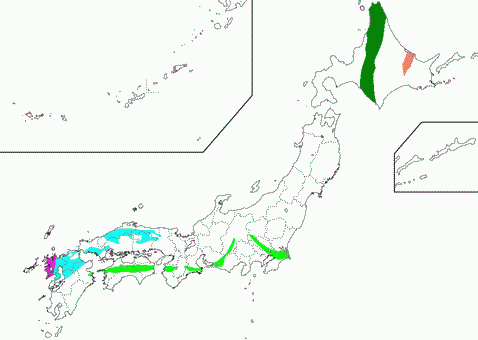High-Pressure Metamorphic Rocks
Synonym
High-Pressure metamorphic belt
Overview
High-P metamorphic rocks formed by subduction of oceanic plates under the east margin of the Eurasian continent. Protoliths of high-P metamorphic rocks are accretionary complexes, and high-P metamorphic rocks distribute along accretionary complexes as bands in the island arc. High-P metamorphic rocks can be treated as members of accretionary complexes. High-P metamorphic rocks are also included as tectonic blocks in serpentine mélanges. Rocks subjected to higher grade of metamorphism than Pumpellyite-Actinolite facies or Greenschist facies are recognized as high-P metamoprhic rocks as they show characteristic structures.
Franciscan facies series (High-P)
Pumpellyite-Actinolite facies > Blueschist facies > Eclogite facies
Sanbagawa f. series (Intermediate high-P)
Pumpellyite-Actinolite facies > Greenschist facies > Epidote-Amphibolite facies

High-P metamorphic rocks distribute as bands along accretionary complexes.
Light blue: Suo Belt and Chizu Belt, Green: Sanbagawa Belt, Dark green: Kamuikotan Belt, Brown: Tokoro Belt, Purple: Nagasaki metamorphic rocks, Red: Yaeyama metamorphic rocks,
Yaeyama metamorphic rocks are considered as a part of Suo Belt, Nagasaki metamorphic rocks as a part of Shimanto metamorphic rocks, and Kamuikotan belt and Tokoro bets are as parts of Sanbagawa belt.
Members
- Motai-Matsugadaira Belt (Cambrian)
- Renge Belt (Carboniferous-Permian)
- Suo Belt (Triassic-Jurassic)
- Chizu Belt (Jurassic)
- Sanbagawa Belt (Middle Cretaceous)
- Kamuikotan Belt (Cretaceous, Sanbagawa)
- Tokoro Belt (Cretaceous, Sanbagawa)
- Nagasaki metamorphic rocks (Late Cretaceous, Shimanto)
- Yaeyama metamorphic rocks (Triassic, Suo Belt)